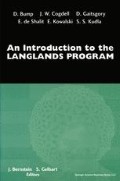Abstract
In this first chapter we will define and describe, in a roughly chronological order from the time of Euler to that of Hecke, some interesting classes of holomorphic functions with strange links to many aspects of number theory. Later chapters will explain how at least some of the mysterious aspects are understood today. But it should be emphasized that there are still many points that are not fully explained, even in a very sketchy, philosophical way.
Access this chapter
Tax calculation will be finalised at checkout
Purchases are for personal use only
Preview
Unable to display preview. Download preview PDF.
Editor information
Editors and Affiliations
Rights and permissions
Copyright information
© 2004 Springer Science+Business Media New York
About this chapter
Cite this chapter
Kowalski, E. (2004). Elementary Theory of L-Functions I. In: Bernstein, J., Gelbart, S. (eds) An Introduction to the Langlands Program. Birkhäuser, Boston, MA. https://doi.org/10.1007/978-0-8176-8226-2_1
Download citation
DOI: https://doi.org/10.1007/978-0-8176-8226-2_1
Publisher Name: Birkhäuser, Boston, MA
Print ISBN: 978-0-8176-3211-3
Online ISBN: 978-0-8176-8226-2
eBook Packages: Springer Book Archive

